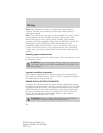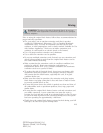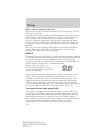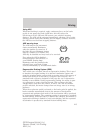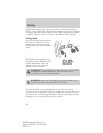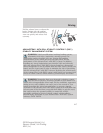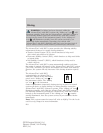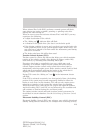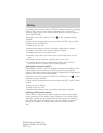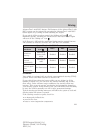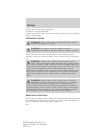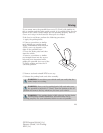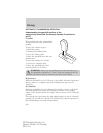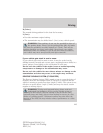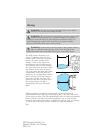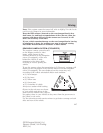
or avoiding objects in the roadway. The ESC system operates by applying
brakes to one or more of the wheels individually and, if necessary,
reducing engine power if the system detects that the vehicle is about to
skid or slide laterally.
During ESC events the “sliding car” icon
in the instrument cluster
will flash.
Certain adverse driving maneuvers may activate the ESC system, which
include but are not limited to:
• Taking a turn too fast
• Maneuvering quickly to avoid an accident, pedestrian or obstacle
• Driving over a patch of ice or other slippery surfaces
• Changing lanes on a snow-rutted road
• Entering a snow-free road from a snow-covered side street, or vice
versa
• Entering a paved road from a gravel road, or vice versa
• Cornering while towing a heavily loaded trailer (refer to Trailer
towing in the Tires, Wheels and Loading chapter).
Roll Stability Control™ (RSC)
Roll Stability Control™ (RSC) may help to maintain roll stability of the
vehicle during adverse maneuvers. RSC operates by detecting the
vehicle’s roll motion and the rate at which it changes and by applying the
brakes to one or more wheels individually.
During an event that activates the RSC, the “sliding car” icon
in the
instrument cluster will flash.
Certain adverse driving maneuvers may activate the RSC system, which
include:
• Emergency lane-change
• Taking a turn too fast
• Quick maneuvering to avoid an accident, pedestrian or obstacle
Switching Off Traction Control
If the vehicle is stuck in snow, mud or sand, and seems to lose engine
power, switching off the traction control features of the AdvanceTrac
with RSC system may be beneficial because the wheels are allowed to
spin. This will restore full engine power and will enhance momentum
through the obstacle. To switch off the traction control press the
Driving
220
2010 Escape Hybrid (ehv)
Owners Guide, 1st Printing
USA (fus)



